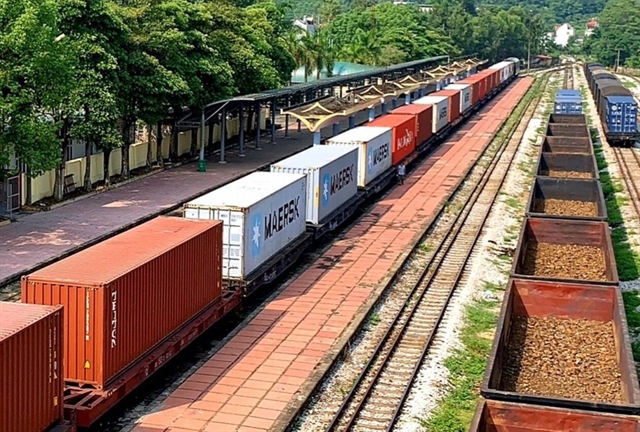
HÀ NỘI — Amid the pandemic and difficulties in logistic transport, the railway industry must work out solutions to accelerate logistics services to reduce challenges for businesses, according to industry insiders.
In July last year, the Vietnam Railways (VNR) added a new rail freight link from Việt Nam to Belgium with the first train departing from Yên Viên station in Hà Nội to arrive at Liege City in Belgium.
Currently, VNR is providing freight train services between Việt Nam and China and transiting to Russia, Europe, ASEAN and Central Asian countries. The firm provides full logistics services to clients.
VNR Chairman Vũ Anh Minh said that with advanced container transport, the travel time by train was between 18-20 days, while sea transport took about 40-45 days.
Minh noted that this was a great competitive advantage of railway transport, especially for products that need good storage conditions and fast delivery.
Minh said many businesses now planned to shift their containers from sea to rail freight.
A representative of the Import-Export Department (Ministry of Industry and Trade), said the increase in Ocean freight rates and shortage of empty containers had made rail freight more competitive. Therefore, the demand for the Asia-Europe railway would not stop at 15 trips per week as it was now.
Nguyễn Hữu Đức, a railway expert, said that amid the global outbreak of COVID-19, international sea freight was facing its most difficult time, and rail freight had become a reliable means of transport transporting goods from Việt Nam to Europe.
The railway has a great advantage due to its rail links with the international rail networks, reasonable freight costs, and low impact on the environment.
Trần Thế Hùng, General Director of Rail Transport and Trade JSC (Ratraco), a member of VNR, said that his company had run three trips per week to Europe. This year, the company was expected to increase the frequency to 4-5 trips per week. It also set a target of running one trip per day to many different destinations in Europe and vice versa.
For this route, all 23 original coaches from Việt Nam would be pulled by China’s Asia-Europe train and later travel through Kazakhstan, Russia, Belarus, Poland, Germany and Belgium as the final destination.
Mai Lê Lợi, general director of VIMC Logistics, said his company was willing to work with Vietnam Railways to conduct new transport routes and offer importers and exporters new transport solutions.
Lợi said the Asia-Europe railway had great potential due to trade turnover between Việt Nam and the Free Trade Agreement between Việt Nam and Eurasian Economic Union but it so far remained modest.
Economists attributed the current problem of railways to the inadequate and small-scale warehouse system that failed to meet the needs of clients.
Hoàng Gia Khánh, VNR deputy general director, said the Vietnamese railway infrastructure system was now seriously degraded with a low capacity of transport.
He attributed these issues to the limitations on railway stations, freight yards, and loads on bridges that are unable to connect with other kinds of transport such as sea freight. Therefore, it was a need to outline investment policies and promote connection with the international railway network.
Vietnamese railways now connect with Chinese railways to transport goods to other countries.
Under the development plan for railway network for 2021-2023 approved by the Government, Vietnamese railways are connected with Chinese railways via two lines starting from Việt Nam’s Đồng Đăng to China’s Ping Xiang, and Việt Nam’s Lào Cai station and China’s North Hekou station.
Experts said upgrading railway infrastructure was a decisive factor, especially the Asia-Europe railway network that helped boost the capacity of rail freight.
Currently, Việt Nam has a narrow track gauge railway while China has switched to a broad gauge one with only short sections in some border provinces still using narrow-gauge tracks.
This means Vietnamese trains from Lào Cai Station can only reach North Hekou Station at the farthest in China. As a result, goods will have to be unloaded from Vietnamese trains to be reloaded onto another train to be transported on China’s railway system. Conversely, Chinese trains can not run to Việt Nam for goods loading. — VnExpress News
- Reduce Hair Loss with PURA D’OR Gold Label Shampoo
- Castor Oil Has Made a “Huge” Difference With Hair and Brow Growth
- Excessive hair loss in men: Signs of illness that cannot be subjective
- Dịch Vụ SEO Website ở Los Angeles, CA: đưa trang web doanh nghiệp bạn lên top Google
- Nails Salon Sierra Madre
 VnExpress News The News Gateway of Vietnam
VnExpress News The News Gateway of Vietnam




